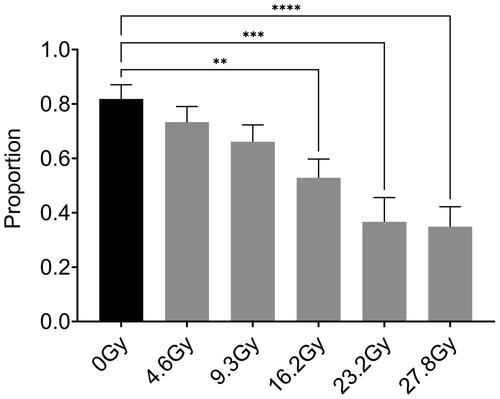Article title: Impacts of ionization radiation on the cuticular hydrocarbon profile and mating success of male house crickets (Acheta domesticus)
Authors: Tamara M. Fuciarelli & C. D. Rollo
Journal: International Journal of Radiation Biology
Bibliometrics: Volume 97, Issue 4; Pages 564–570
DOI: https://doi.org/10.1080/09553002.2021.1876954
In the original version of this article, published online 11 February 2021, the authors had incorrectly calculated the dose-rate calculation. The dose-rate originally detailed at a distance of 16.4 cm was quoted as 0.25 Gy/min, but it has since been discovered that it was 0.58 Gy/min, affecting the total doses that the specimens were exposed to. Thus, throughout the paper (including the figures), doses of 0, 2, 4, 7, 10 and 12 Gy are replaced with 0, 4.6, 9.3, 16.2, 23.2 and 27.8 Gy, respectively.
The authors apologize for this error and wish to correct the literature. The authors confirm that no other aspects of the article were impacted by this error and that these changes do not impact the validity of their results.
The authors apologize for any inconvenience that may have been caused.
Figure 2. Dose–response effects of early life radiation on cuticular hydrocarbons, specifically the effect on each of the 26 significant hydrocarbon peaks identified using gas-liquid chromatography. All individuals were irradiated at 14 days of age at 0.58 Gy/min with hydrocarbon extraction occurring 1-week post maturation. Values are shown as the mean area under each peak/concentration at each dose þ/ SEM; 0 Gy (n = 6), 4.6 Gy (n = 6), 9.3 Gy (n = 5), 16.2 Gy (n = 5), 23.2 Gy (n = 6), and 27.8 Gy (n = 6). Significant impacts were identified for peak 22; 4.6 Gy (p=.0014), 9.3 Gy (p=.0080), 16.2 Gy (p<.0001), and 27.8 Gy (p=.0124) and peak 23; 4.6 Gy (p<.0001), 9.3 Gy (p<.0001), 16.2 Gy (p<.0001), 23.2 Gy (p=.0303) and 27.8 Gy (p<.0001) compared to control values. All significant differences were analyzed compared to control values using a 2-way ANOVA followed by Dunnett’s multiple comparison test. Mass of the cricket was control for when extracting hydrocarbons.

Figure 3. Effects of early life radiation on male Acheta domesticus mating success. Males were irradiated at 14 days of age (0–27.8 Gy) at a dose rate of 0.58 Gy/ min and paired with normal unirradiated females 2–3 weeks post maturation. Success was indicated as female mounting of males. A one-way ANOVA indicated significant differences between groups (F(5,294) = 2.386, p<.0001). A Dunnett’s multiple comparisons test indicated significant differences in mating success in 27.8 Gy (p<.0001), 23.2 Gy (0.0001), and 16.2 Gy (0.0060) groups compared to non-irradiated controls.

